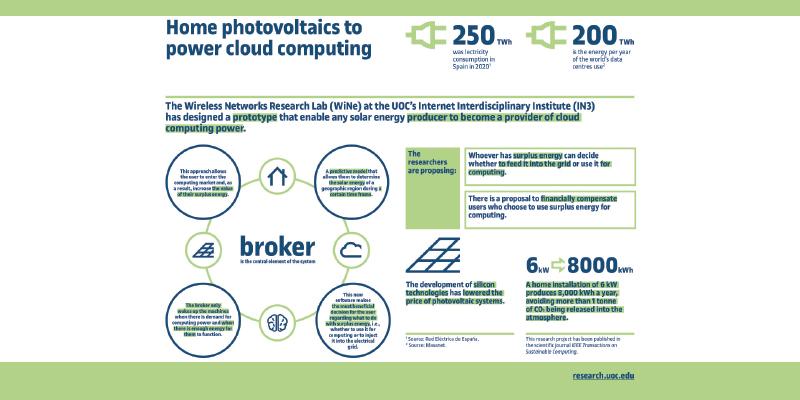A prototype designed by the UOC (Universitat Oberta de Catalunya/ Open University of Catalonia – Barcelona) uses installed solar power for computing applications. The system will help to reduce greenhouse gas emissions and reward small producers
According to figures from Masanet et al on total energy use by data centres, simple actions, such as sending an email or saving a photo to the cloud, when multiplied by all the users in the world, account for 200 TWh (terawatt hours).
To get an idea of these figures, total power consumption in Spain in 2020 was 250 TWh, according to figures from Red Eléctrica de España, the corporation which operates the national electricity grid.
A team of researchers from the UOC has designed a prototype to allow any person whose roof receives direct sunlight to install a photovoltaic system in their home and become a potential supplier of computing power.
“It’s like the batteries that many users are now incorporating into their set-ups – an optional element of the photovoltaic system,” explained Borja Martínez and Xavier Vilajosana, the authors of the study and members of the Wireless Networks (WiNE) research group of the UOC’s Internet Interdisciplinary Institute (IN3), of which Prof. Vilajosana is head researcher.
The prototype, described in the journal IEEE Transactions on Sustainable Computing, emulates the components of a typical residential photovoltaic facility.
The central element of the system, known as the broker, is a software component which manages the functions of the system and decides which actions are of most benefit to the user in each situation. “To give an example, the broker can act on computers when they are in sleep mode, ‘waking them up’ to enable them to be used for computing applications,” said the researchers.
They have also developed a predictive model to determine the available solar energy in a given geographical area and time band, so that the broker only ‘wakes up’ computers when the power they need to operate is available.
The philosophy behind the project is based on a zero-sum collaborative economy. As the authors point out, participants with the necessary physical resources – solar-powered computers – make them available to those who need computing power but do not have the infrastructure.
In this regard, Martínez and Vilajosana suggest that those users providing the energy resources receive some form of compensation, similar to shared ride services, under which car owners make free space available to people who need to travel but do not own a vehicle, in exchange for a payment to help them offset the costs of the journey.
Benefits for small producers
How is using solar power, a renewable energy, affected by adverse weather conditions?
“If it is not sunny, that particular user will not be able to offer their resources to the computing pool at that specific moment. However, the idea is to have many suppliers in different areas, because it is always sunny somewhere,” said Martínez and Vilajosana.
At the other end of the system, any user generating more power than they can use can always inject it into the grid. Thus, small producers obtain benefits at every turn.
“Our idea is to reward small producers for using a resource already available to them. And, more importantly, we believe that this payment may encourage the installation of new domestic systems wherever possible,” said the researchers.
The system will help to reduce greenhouse gas emissions. In Spain a typical 6 kW domestic installation generates some 8,000 kWh each year, which means a reduction of more than a tonne of CO2 emissions each year, the researchers calculate.
Critical mass to drive change
The system is based on a combination of two trends.
First, the recent upsurge in distributed computing, a technology which, nevertheless, has been in existence for more than 15 years and which was popularised by projects such as the SETI@home screensaver, which scanned for signs of extra-terrestrial life while domestic computers were inactive.
And second, developments in silicon technologies have led to a major drop in the price of solar panels in recent years, making photovoltaic systems economically competitive.
“Right now, the conditions are right to create a critical mass of both producers, the providers of computing resources, and consumers, the persons and businesses who could lease these resources, knowing that by doing so they are helping to create a better environment,” said the pair.
REF: Martínez, B., and Vilajosana, X. “Exploiting the Solar Energy Surplus for Edge Computing”. IEEE Transactions on Sustainable Computing. DOI: 10.1109/TSUSC.2021.3058588






